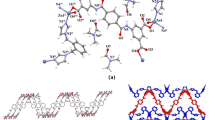Abstract
Herein, the synthesis and characterization of a novel chiral Schiff bases derived from ferrocene, coded as 3, have been reported. The sensing behavior of the synthesized compound has been examined towards the enantiomers of some amino acids (methionine, alanine, serine, histidine, and threonine) by spectrofluorimetric method. The fluorescence response of compound 3 showed noticeable enhancement upon addition of d-methionine compared to l-methionine and kept nearly linear correlation with the concentration of d-methionine. The value of enantiomeric fluorescence difference ratio (ef) has been determined to be 1.54 when d - and l- methionine amount is 100 times more than compound 3. The results showed that the compound 3 can be used as a sensor for enantio-selective recognition of d-methionine.








Similar content being viewed by others
References
Ahumada G, Roisnel T, Sinbandhit S, Manzur C, Carrillo D, Hamon JR (2013) Synthesis, characterization and X-ray crystal structures of chiral ferrocene-containing β-diketones. J Organomet Chem 737:1–6. doi:10.1016/j.jorganchem.2013.03.032
Anupama B, Sunita M, Shiva Leela D, Ushaiah B, Gyana Kumari C (2014) Synthesis, spectral characterization, DNA binding studies and antimicrobial activity of Co (II), Ni (II), Zn (II), Fe(III) and VO (IV) complexes with 4-aminoantipyrine schiff base of ortho-vanillin. J Fluoresc 24:1067–1076. doi:10.1007/s10895-014-1386-z
Benesi HA, Hildebrand JH (1949) A spectrophotometric investigation of the interaction of iodine with aromatic hydrocarbons. J Am Chem Soc 71:2703–2707. doi:10.1021/ja01176a030
Dhara K, Sarkar K, Roy P, Nandi M, Bhaumik A, Banerjee P (2008) A highly enantioselective fluorescent sensor for mandelic acid by chiral Schiff-base compound. Tetrahedron 64:3153–3159. doi:10.1016/j.tet.2008.01.099
Dikusar EA (2011) Synthesis of chiral azomethines from methyl l-3-phenylalaninate hydrochloride and substituted benzaldehydes of vanillin series. Russ J Org Chem 47:202–206. doi:10.1134/S1070428011020084
Dogan Ö, Şenol V, Zeytinci S, Koyuncu H, Bulut A (2005) Efficient synthesis of ferrocenylenones by Friedel-Crafts acylation with EtAlCl2–Me3Al. J Org Chem 690:430–434. doi:10.1016/j.jorganchem.2004.09.055
Gao J, Guo Y, Wang Jun, Wang Z, Jin X, Cheng C, Li Y, Li K (2011) Spectroscopic analyses on interaction of o-vanillin-d-phenylalanine, o-vanillin-l-tyrosine and o-vanillin-l-levodopa Schiff bases with bovine serum albumin (BSA). Spectrochim Acta A 78:1278–1286. doi:10.1016/j.saa.2010.12.077
Ghosh K, Sarkar T (2013) l-Valine derived benzimidazole based bis-urea in enantioselective fluorescence sensing of l-tartrate. Tetrahedron Lett 54:4568–4573. doi:10.1016/j.tetlet.2013.06.087
Ghosh K, Sarkar T (2014) Anthracene-labeled pyridinium-based symmetrical chiral chemosensor for enantioselective recognition of l-tartrate. Tetrahedron Lett 55:1342–1346. doi:10.1016/j.tetlet.2014.01.016
Guang-Yan Q, Hai-Juan Q, He YB, Chen-Guang H, Feng W, Ling H (2008) Enantioselective fluorescent recognition of amino alcohol based on calix[4]arenes bearing diphenylethylenediamine units. Supramol Chem 20(3):265–271. doi:10.1080/10610270701200180
Guidance for industry Q2b validation of analytical procedures: methodology, European medicines agency, London, 1996
Gül A, ter Akh Z, Behatti A, Siddiq M, Khan A, Siddiqe HM, Janjua NK, Shaheen A, Sarfraz S, Mirza B (2012) Synthesis, physicochemical studies and potential applications of high-molecular-weight ferrocene-based poly(azomethine)ester and its soluble terpolymers. J Org Chem 719:41–53. doi:10.1016/j.jorganchem.2012.08.010
Gupta SR, Mourya P, Singh MM, Singh VP (2014) Synthesis, structural, electrochemical and corrosion inhibition properties of two new ferrocene Schiff bases derived from hydrazides. J Org Chem 767:136–143. doi:10.1016/j.jorganchem.2014.05.038
He X, Cui X, Li M, Lin L, Liu X, Feng X (2009) Highly enantioselective fluorescent sensor for chiral recognition of amino acid derivatives. Tetrahedron Lett 50:5853–5856. doi:10.1016/j.tetlet.2009.08.006
Ikeda H, Li Q, Ueno A (2006) Chiral recognition by fluorescent chemosensors based on N-dansyl-amino acid-modified cyclodextrins. Bioorg Med Chem Lett 16:5420–5423. doi:10.1016/j.bmcl.2006.07.069
Li D, Yang Y, Yang C, Hu B, Huo B, Xue L, Wang A, Yu F (2014) Synthesis of cholate-based pyridinium receptor and its recognition toward l-tryptophan. Tetrahedron 70:1223–1229. doi:10.1016/j.tet.2013.12.068
Li Q, Zhang JH, Cai Y, Qu WJ, Gao GY, Lin Q, Yao H, Zhang YM, Wei TB (2015) A facile colorimetric and fluorescent cyanide chemosensor: utilization of the nucleophilic addition induced by resonance-assisted hydrogen bond. Tetrahedron 71:857–862. doi:10.1016/j.tet.2014.12.047
Lu Q, Hou J, Wang J, Xu B, Zhang J, Yu X (2013) Multichannel chromogenic and chiral anions recognition by imidazolium functionalized BINOL derivatives. Chin J Chem 31:641–650. doi:10.1002/cjoc.201300115
Meng J, Wei G, Huang X, Dong Y, Cheng Y, Zhu C (2011) A fluorescence sensor based on chiral polymer for highly enantioselective recognition of phenylalaninol. Polymer 52:363–367. doi:10.1016/j.polymer.2010.12.011
Miao F, Zhou J, Tian D, Li H (2012) enantioselective recognition of mandelic acid with (R)-1,1-Bi-2-naphthol-linked calix[4]arene via fluorescence and dynamic light scattering. Org Lett 14:3572–3575. doi:10.1021/ol3007919
Mirri G, Bull SD, Horton PN, James TD, Male L, Tucker JHR (2010) Electrochemical method for the determination of enantiomeric excess of binol using redox-active boronic acids as chiral sensors. J Am Chem Soc 132:8903–8905. doi:10.1021/ja103462x
Xu Y, Zheng L, Huang X, Cheng Y, Zhu C (2010) Fluorescence sensors based on chiral polymer for highly enantioselective recognition of phenylglycinol. Polymer 51:994–997. doi:10.1016/j.polymer.2010.01.038
Xu SY, Hu B, Flower SE, Jiang YB, Fossey JS, Deng WP, James D (2013) Colorimetric enantioselective recognition of chiral secondary alcohols via hydrogen bonding to a chiral metallocene containing chemosensor. Chem Commun 49:8314–8316. doi:10.1039/C3CC43083A
Zhang M, Lu W, Zhou J, Du G, Jiang L, Ling J, Shen Z (2014a) A simple and effective fluorescent chemosensor for the cascade recognition of Zn2+ and H2PO4 − ions in protic media. Tetrahedron 70:1011–1015. doi:10.1016/j.tet.2013.10.099
Zhang X, Yin J, Yoon J (2014b) Recent advances in development of chiral fluorescent and colorimetric sensors. Chem Rev 114:4918–4959. doi:10.1021/cr400568b
Zhou XB, Chan WH, Lee AWM, Yeung CC, Beilstein (2011) Ratiometric fluorescent probe for enantioselective detection of d-cysteine in aqueous solution. J Org Chem 7:1508–1515. doi:10.3762/bjoc.7.176
Zhu L, Zhang D, Qu D, Wang Q, Ma X, Yian H (2010) Dual-controllable stepwise supramolecular interconversions. Chem Comm 46:2587–2589. doi:10.1039/B926323C
Acknowledgements
The authors are grateful to the grant sponsored by the Scientific Research Projects (BAP-13201020) of Selcuk University.
Author information
Authors and Affiliations
Corresponding author
Electronic supplementary material
Below is the link to the electronic supplementary material.
Rights and permissions
About this article
Cite this article
Ucar, A., Findik, M., Bingol, H. et al. Organometallic chiral Schiff base for enantio-selective fluorescent recognition of methionine. Chem. Pap. 71, 1855–1862 (2017). https://doi.org/10.1007/s11696-017-0179-7
Received:
Accepted:
Published:
Issue Date:
DOI: https://doi.org/10.1007/s11696-017-0179-7




